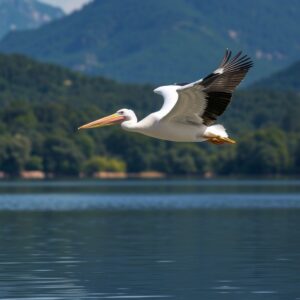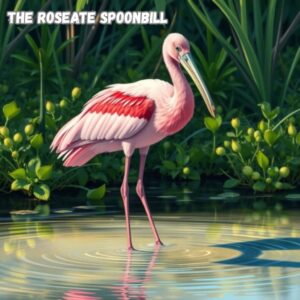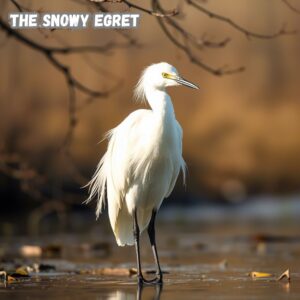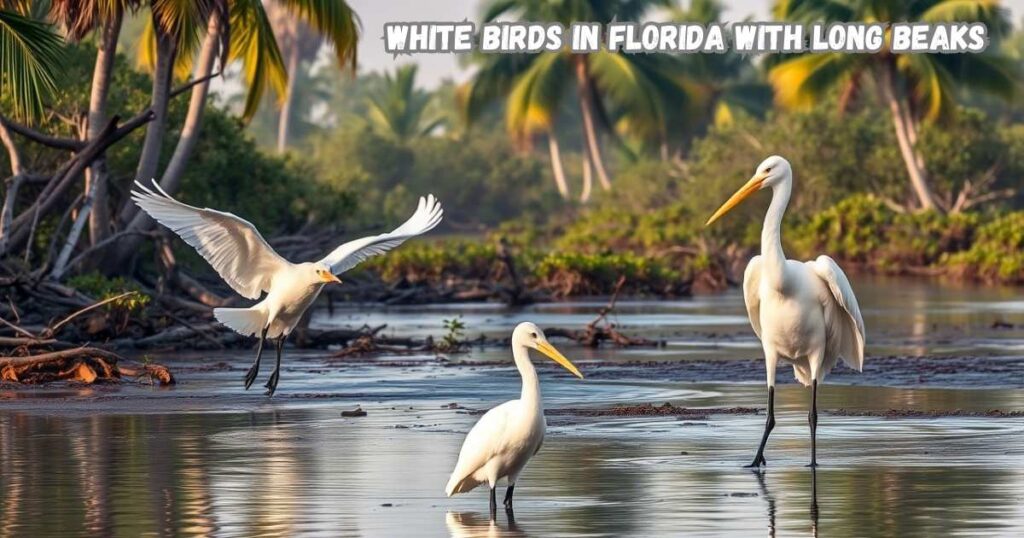Florida is home to many amazing birds. You’ll often see a big white bird with long beak standing in shallow water or flying above the trees. These birds love warm weather, wetlands, and open skies. Whether it’s a white bird in Florida with long beak or one with a curved bill, each one is special. Some are large and graceful, while others are tiny and fast.
You may spot a Florida white bird with long beak near marshes or coastal waters. There are even small white birds in Florida with bright legs and sharp beaks. One type, the white bird curved beak Florida, uses its beak to dig in the mud for food. These birds live in ponds, swamps, and mangroves. From sunrise to sunset, you’ll find these beautiful creatures across the state. If you love nature, watch for birds in Florida—they’re everywhere. Spotting birds in Florida can be a magical experience.
List of Top 10 Long Beaks White Birds in Florida
Florida is full of fascinating wildlife, especially when it comes to birds. This sunny state is home to many long-beaked, white-feathered wonders. These birds in Florida are easy to spot near water and wetlands.
In this guide, you’ll explore a list of top 10 long beaks white birds in Florida. These birds in Florida include wading birds, coastal flyers, and swamp dwellers. Many people enjoy watching birds in Florida for their beauty and charm.
1 . The Great Egret
The Great Egret is a big white bird with long beak and long neck. People also call it the common egret or large egret. It’s one of the most graceful birds in Florida.
This white bird in Florida with long beak lives near marshes, ponds, swamps, and shallow water. You’ll often see it in Southern Florida, standing still while hunting fish and frogs. It also lives across Central America and parts of South America.
The Great Egret can live up to 15 years in the wild. Its long, sharp beak helps it catch prey fast. This Florida white bird with long beak builds nests in trees with other colonial nesters during the breeding season.
Read More: Top 9 Mythical Birds
2 . The Wood Stork

The Wood Stork is a big white bird with long beak and black-tipped wings. It stands over 3 feet tall and has a wingspan of nearly 5 feet. These birds can live up to 20 years.
They eat fish, frogs, snakes, and aquatic insects. Using their long beaks, they snap food in shallow water. Their hunting style is called touch feeding, where they stir the water with their feet to catch prey.
Wood Storks live in swamps, marshes, and coastal mangroves in South Florida and other warm places. They build nests high in trees and bushes, often in groups called colonial nesters.
3 . The American White Pelican

The American White Pelican is one of the largest white birds in North America. It has a long orange beak and huge wings that can reach 9 feet wide. These birds often glide gracefully in the sky or float in water.
They mostly eat fish like minnows and small carp. Sometimes, they’ll eat salamanders or crayfish too. Instead of diving, they scoop up fish while swimming. Group feeding helps them catch more food by working together.
American White Pelicans live near lakes, marshes, and coastal waters. In Florida, they visit during the winter months. They prefer quiet spots for nesting and resting. Their average lifespan in the wild is about 15 to 25 years.
4. The Roseate Spoonbill

The Roseate Spoonbill is a stunning wading bird known for its bright pink feathers and spoon-shaped bill. It’s a white bird in Florida with long beak, though the pink stands out most. These birds live up to 15 years in the wild.
They eat small fish, crayfish, aquatic insects, and shrimp. Their spoon-shaped bill helps them stir mud with their feet and scoop food from shallow water. It’s fun to watch their unique feeding behavior—they sweep their bills side to side while walking.
You’ll find them in marshes, swamps, coastal mangroves, and ponds, especially in South Florida, coastal Texas, and South America. They prefer warm, quiet waters where food is easy to catch. These aquatic birds often live in groups called colonies and build nests in trees and bushes near water.
5. The White Ibis

The White Ibis is a white bird in Florida with long beak that’s easy to spot in wetlands and parks. It has a curved orange beak, red legs, and bright white feathers. These birds are wading birds, often seen in groups. They usually live about 10 to 15 years in the wild.
White Ibises love feeding in shallow water. They eat crayfish, insects, snails, frogs, and even small fish. Using their curved beaks, they poke into the mud to find food. This feeding style is called bill probing, and they’re really good at it. They forage alone or in groups, often stirring the mud with their feet.
You’ll find them in marshes, swamps, and coastal mangroves across Florida, Southern Florida, and the Gulf Coast. The White Ibis nests in trees near water. They’re colonial nesters, which means they build nests close together. These friendly-looking birds are a favorite among locals and bird watchers alike.
6. The Snowy Egret

The Snowy Egret is a small, graceful white bird with long black legs and bright yellow feet. It’s easy to spot thanks to its smooth white feathers and slender black beak. These elegant birds are often seen in shallow waters, standing still or walking slowly as they search for food.
They usually live in marshes, swamps, ponds, and along coastlines. You’ll find them across Florida, especially in wetlands and mangroves. The Snowy Egret builds its nest in trees or shrubs near water, often as part of a large group. Their nests are messy platforms made from sticks, and they prefer quiet, safe spots for raising their young.
When it comes to food, they aren’t picky. Snowy Egrets eat fish, shrimp, frogs, aquatic insects, and even small snakes. They use quick, clever hunting moves to catch their prey. These birds can live up to 17 years in the wild if they stay safe from danger.
7. The Tricolored Heron
The Tricolored Heron is a slender, elegant bird often seen wading through shallow water. It has a long neck, thin legs, and a sharp beak. This bird usually lives around marshes, swamps, and coastal mangroves. Tricolored Herons can live up to 15 years in the wild.
They mainly eat fish, frogs, crustaceans, and aquatic insects. You’ll often see them standing still or walking slowly as they hunt. Their favorite trick? Stirring the mud with their feet to scare up food. These herons are quiet, shy, and prefer peaceful wetlands to build nests and raise their young.
8. The Little Blue Heron
The Little Blue Heron is a graceful wading bird often found in wetlands across the southeastern United States. It starts life with white plumage, later turning a soft blue-gray. This species is one of the most fascinating birds in Florida, known for its quiet nature and slow, deliberate movements while hunting.
These birds mostly live in marshes, swamps, and shallow ponds. You’ll often find them in Florida white bird with long beak habitats, especially in places like mangroves and cypress domes. They prefer calm, freshwater spots rich with food. As typical birds in Florida, they stay close to water, nesting in colonies with other wading birds.
When it comes to food, the Little Blue Heron enjoys a varied diet. They eat fish, frogs, insects, crustaceans, and even small reptiles. Their sharp beak helps them catch prey quickly. This white bird in Florida with long beak uses stealth to get close before striking.
The lifespan of the Little Blue Heron can reach up to 10–15 years in the wild. During the breeding season, their plumage darkens, and they build nests high in trees. These birds in Florida often share nesting sites with other species, forming large colonies that stay active through spring and summer.
9. The White faced Ibis
The White-faced Ibis is a wading bird with glossy feathers that shine green and purple in sunlight. It has a long, curved beak and red eyes during breeding season. These birds in Florida are often seen near marshes and shallow waters, walking slowly while they search for food.
They live in wetlands like swamps, ponds, and coastal mangroves. You can also find them in the Gulf Coast and southern Florida. The White-faced Ibis builds its nest in thick vegetation or trees near water. These birds in Florida prefer quiet spots for nesting and raising their young.
Their diet includes insects, frogs, fish, and crustaceans. They use their curved beak to probe the mud for food. The average lifespan of a White-faced Ibis in the wild is around 9 to 10 years. They often feed in groups and may migrate depending on the season and habitat changes.
10. The Glossy Ibis
The Glossy Ibis is a striking wading bird known for its dark, shiny feathers that glow with green and purple in the sunlight. Though it looks dark from far away, its plumage is full of color up close. It has long legs and a long, curved beak perfect for foraging.
These birds live in wetlands like marshes, swamps, and shallow ponds. You’ll often see them in South Florida, coastal mangroves, and cypress domes. They like to stay in large groups called colonies, especially during the breeding season. Their nests are built in trees or shrubs near water. Glossy Ibises can live up to 20 years in the wild.
When it comes to food, Glossy Ibises aren’t picky. They eat insects, crayfish, frogs, snails, and even small fish. They use their curved beaks to probe in the mud, a behavior called bill probing. Watching them hunt in shallow water is a treat for bird lovers.
FAQ’S
What are the most common white birds in the state?
Birds in Florida like egrets, ibises, and herons are commonly seen in wetlands, swamps, and coastal areas across the state.
Where can I see rare bird species?
Look for birds in Florida in protected reserves, state parks, and wildlife refuges such as Everglades and Merritt Island.
Are there migratory birds found here?
Yes, many birds in Florida migrate seasonally from Central and South America, especially during spring and fall months.
What do wading birds eat?
Most wading birds in Florida eat small fish, insects, frogs, and crustaceans they catch in shallow water using their long beaks.
Are any bird species protected by law?
Yes, some birds in Florida are listed as endangered or under protected status due to habitat loss and environmental threats.
Conclusion
Birds in Florida are a joy to watch. From tall wading birds to small songbirds, they bring color and life to the land. You can see a big white bird with long beak near marshes or a white bird curved beak Florida digging in the mud. These birds live in swamps, ponds, and mangroves. Some stay all year, while others are migratory birds flying in and out with the seasons.
You’ll also spot small white birds in Florida hopping near the shore or nesting in trees. Each bird has its own beak structure, wingspan, and way of life. Many are breeding birds, building nests and raising juvenile birds during the breeding season. Their beauty is more than skin-deep—they help nature stay balanced. Whether you’re in the city or the wild, keep your eyes open. Birds in Florida are all around, adding wonder to every day.


1 thought on “10 White Birds in Florida with Long Beaks”